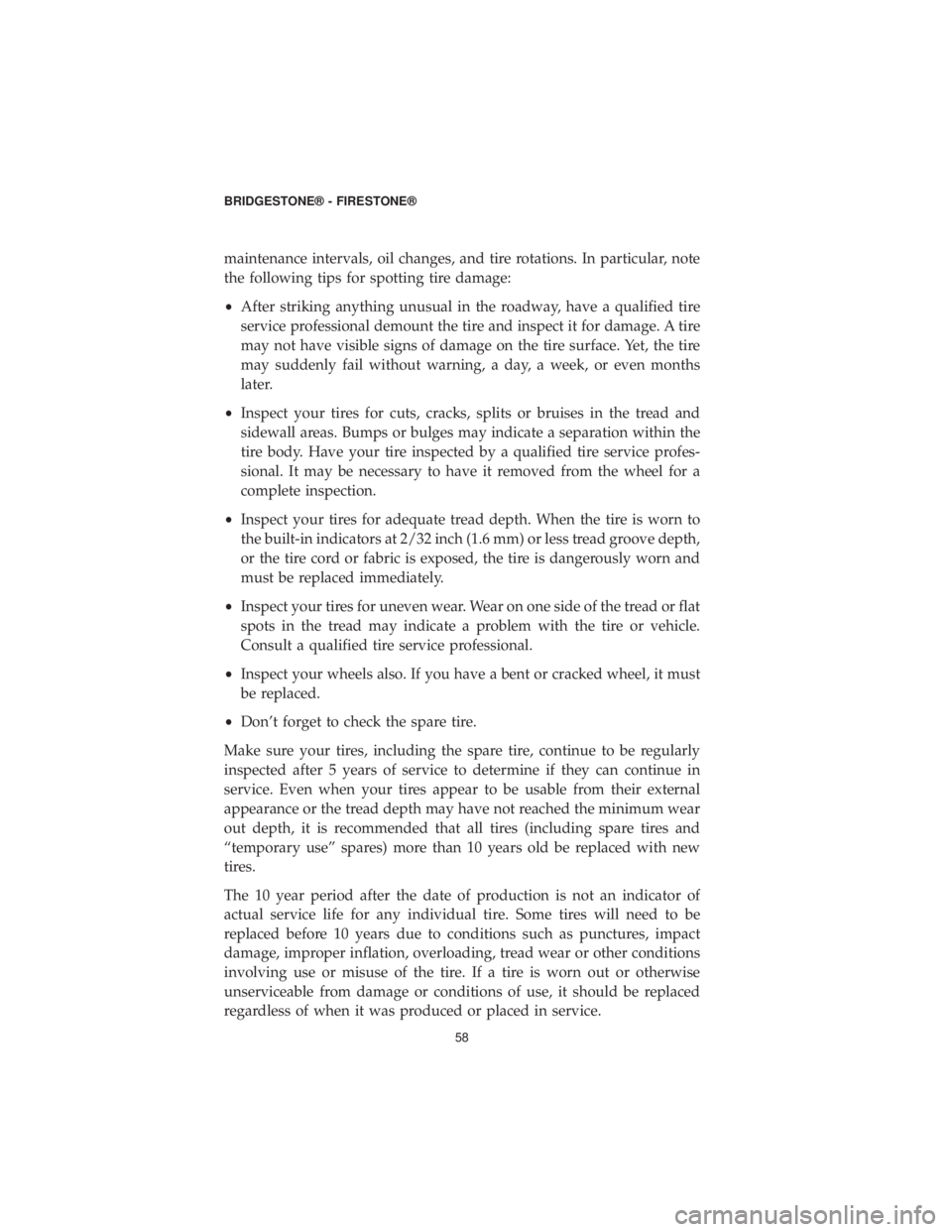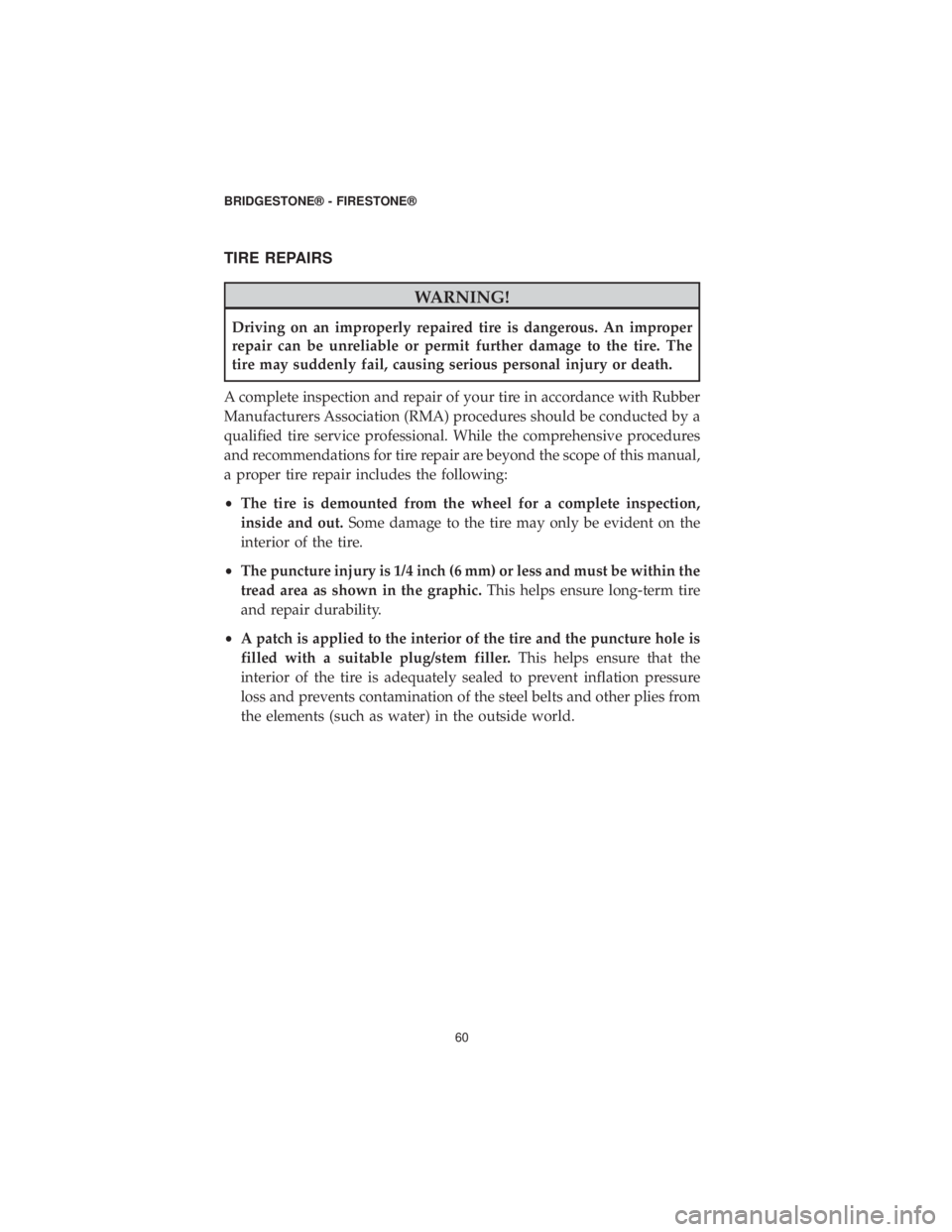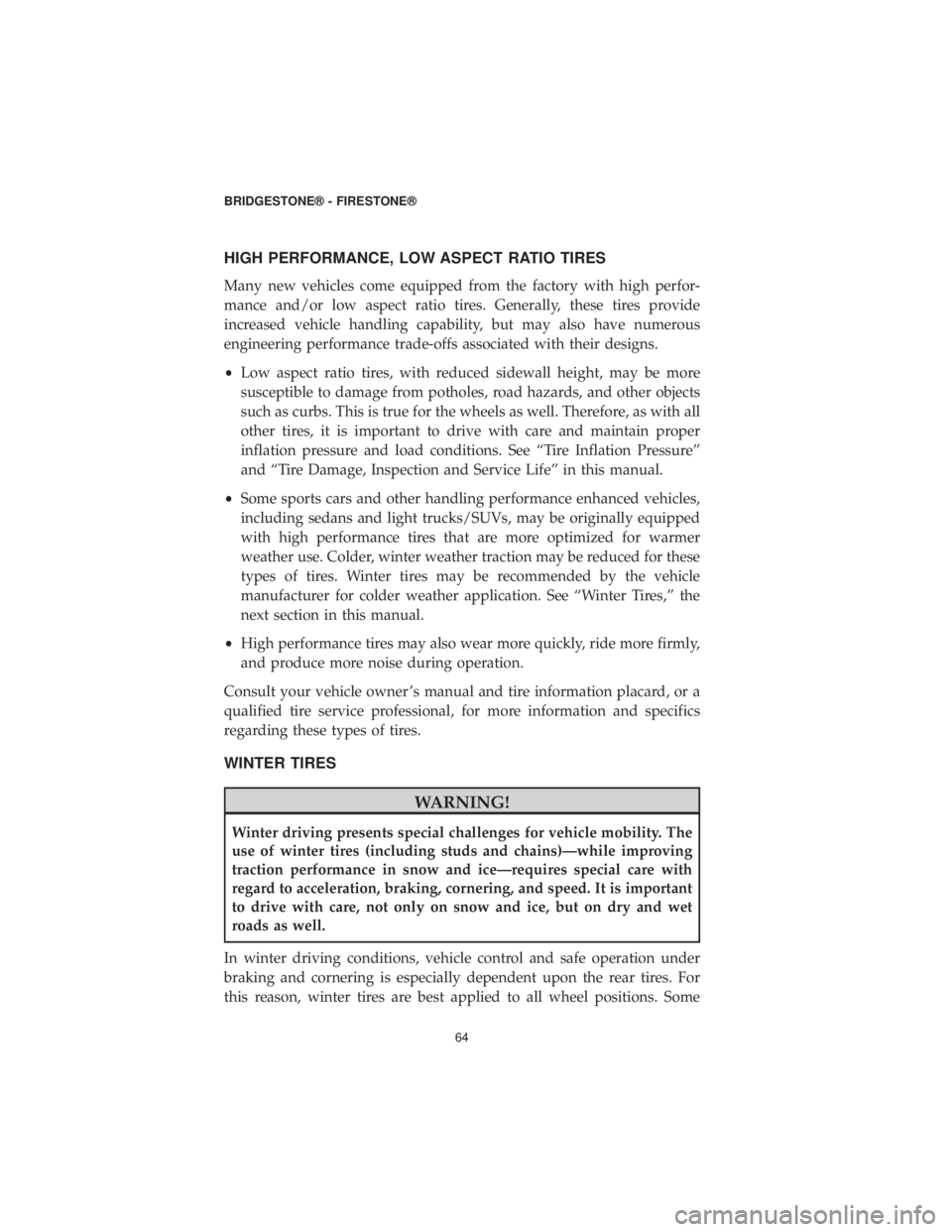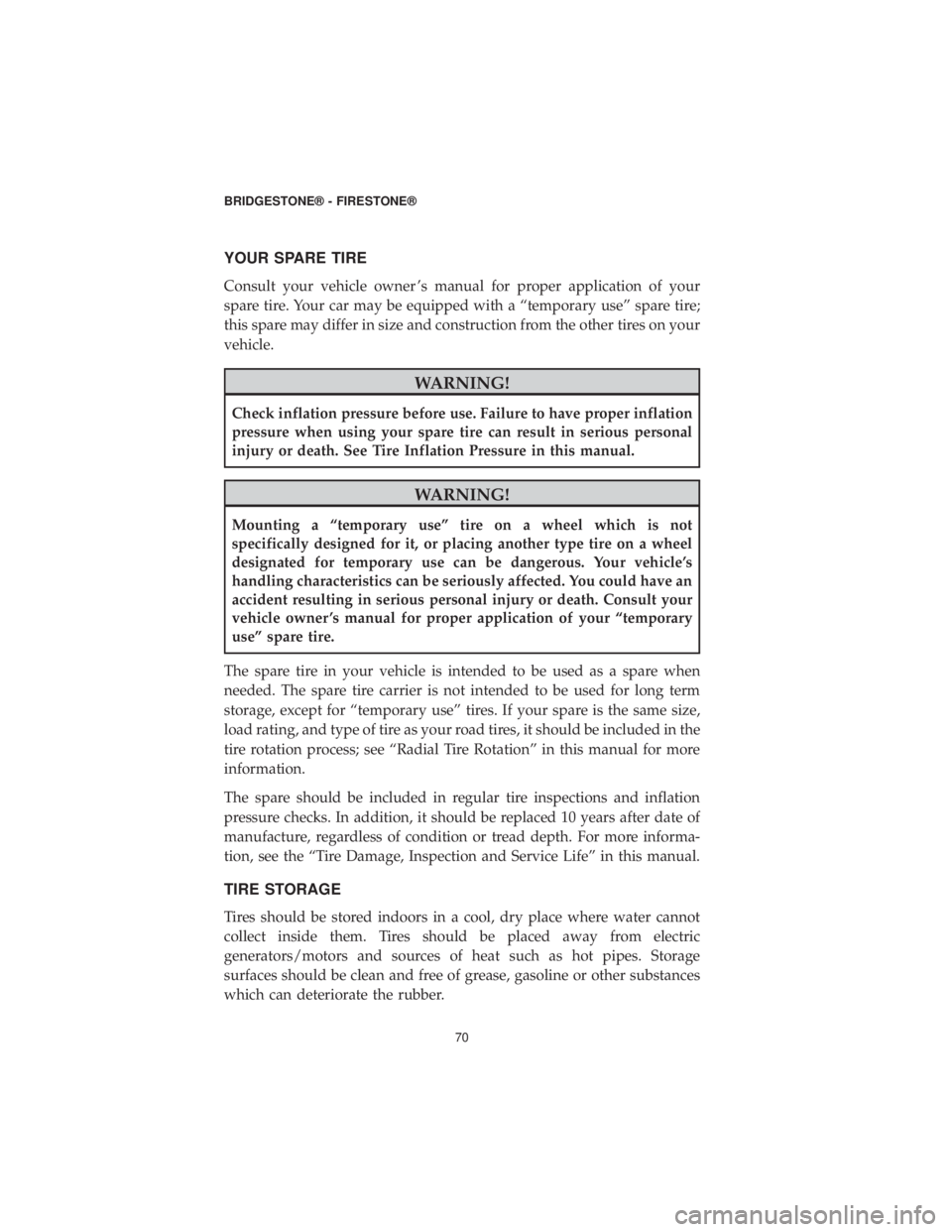warning DODGE DURANGO SRT 2019 Vehicle Warranty
[x] Cancel search | Manufacturer: DODGE, Model Year: 2019, Model line: DURANGO SRT, Model: DODGE DURANGO SRT 2019Pages: 270, PDF Size: 2.52 MB
Page 58 of 270

TIPS FOR SAFE LOADING
WARNING!
Driving your vehicle in an overloaded condition is dangerous.
Overloading causes excessive tire heat build-up and internal
structural damage. This can cause a tire failure, even at a later date,
which could lead to serious personal injury or death. Consult the
vehicle tire information placard, certification label, and owner ’s
manual for the recommended vehicle load limits and loading
recommendations.
• Always keep the vehicle manufacturer ’s recommended inflation pres-
sure in all your tires, including the spare. Check their pressure monthly
and before long trips or carrying extra weight.
• Never exceed the maximum load rating stamped on the sidewall of
your tire.
• Never exceed the gross vehicle weight rating (GVWR) or front/rear
gross axle weight ratings (GAWR) of your vehicle.
• Consult your vehicle owner ’s manual for load recommendations and
special instructions (such as for trailer/towing and snow plow
installations).
TIRE DAMAGE, INSPECTION AND SERVICE LIFE
Evaluation and maintenance of your tires is important to their perfor-
mance and the service they provide to you. Over time and/or through
use, the condition of a tire can change from exposure to everyday road
conditions, the environment, damaging events such as punctures, and
other external factors.
WARNING!
Driving on damaged tires is dangerous. A damaged tire can
suddenly fail causing serious personal injury or death. Have your
tires regularly inspected by a qualified tire service professional.
You should visually inspect your tires on a regular basis throughout their
life, and you should have your tires periodically evaluated by a qualified
tire service professional when your vehicle is serviced such as routine
BRIDGESTONE® - FIRESTONE®
57
Page 59 of 270

maintenance intervals, oil changes, and tire rotations. In particular, note
the following tips for spotting tire damage:
•After striking anything unusual in the roadway, have a qualified tire
service professional demount the tire and inspect it for damage. A tire
may not have visible signs of damage on the tire surface. Yet, the tire
may suddenly fail without warning, a day, a week, or even months
later.
• Inspect your tires for cuts, cracks, splits or bruises in the tread and
sidewall areas. Bumps or bulges may indicate a separation within the
tire body. Have your tire inspected by a qualified tire service profes-
sional. It may be necessary to have it removed from the wheel for a
complete inspection.
• Inspect your tires for adequate tread depth. When the tire is worn to
the built-in indicators at 2/32 inch (1.6 mm) or less tread groove depth,
or the tire cord or fabric is exposed, the tire is dangerously worn and
must be replaced immediately.
• Inspect your tires for uneven wear. Wear on one side of the tread or flat
spots in the tread may indicate a problem with the tire or vehicle.
Consult a qualified tire service professional.
• Inspect your wheels also. If you have a bent or cracked wheel, it must
be replaced.
• Don’t forget to check the spare tire.
Make sure your tires, including the spare tire, continue to be regularly
inspected after 5 years of service to determine if they can continue in
service. Even when your tires appear to be usable from their external
appearance or the tread depth may have not reached the minimum wear
out depth, it is recommended that all tires (including spare tires and
“temporary use” spares) more than 10 years old be replaced with new
tires.
The 10 year period after the date of production is not an indicator of
actual service life for any individual tire. Some tires will need to be
replaced before 10 years due to conditions such as punctures, impact
damage, improper inflation, overloading, tread wear or other conditions
involving use or misuse of the tire. If a tire is worn out or otherwise
unserviceable from damage or conditions of use, it should be replaced
regardless of when it was produced or placed in service.
BRIDGESTONE® - FIRESTONE®
58
Page 61 of 270

TIRE REPAIRS
WARNING!
Driving on an improperly repaired tire is dangerous. An improper
repair can be unreliable or permit further damage to the tire. The
tire may suddenly fail, causing serious personal injury or death.
A complete inspection and repair of your tire in accordance with Rubber
Manufacturers Association (RMA) procedures should be conducted by a
qualified tire service professional. While the comprehensive procedures
and recommendations for tire repair are beyond the scope of this manual,
a proper tire repair includes the following:
• The tire is demounted from the wheel for a complete inspection,
inside and out. Some damage to the tire may only be evident on the
interior of the tire.
• The puncture injury is 1/4 inch (6 mm) or less and must be within the
tread area as shown in the graphic. This helps ensure long-term tire
and repair durability.
• A patch is applied to the interior of the tire and the puncture hole is
filled with a suitable plug/stem filler. This helps ensure that the
interior of the tire is adequately sealed to prevent inflation pressure
loss and prevents contamination of the steel belts and other plies from
the elements (such as water) in the outside world.
BRIDGESTONE® - FIRESTONE®
60
Page 63 of 270

•Any tire repair done without removing the tire from the wheel is
improper. The tire must be demounted from the wheel and the interior
inspected for damage that may not be evident on the exterior of the
tire.
• Using only a plug/stem, or using only a patch, is not a safe or proper
repair. A patch must be applied to the interior of the tire and the
puncture hole must be filled with a suitable plug/stem filler to prevent
inflation pressure loss and contamination of the steel belts and other
plies.
• NEVER substitute a tube for a proper repair or to remedy an improper
repair.
• Tubes, like tires, should only be repaired by a qualified tire service
professional.
• Some vehicle manufacturers do not recommend using repaired tires.
Consult your vehicle owner ’s manual or contact the vehicle manufac-
turer before operating a repaired tire on your vehicle.
ASK how your tire will be repaired. ALWAYS insist on a proper tire
repair.
Emergency/Temporary Sealant or Filler Repairs: An emergency/
temporary sealant or filler injected into the tire, such as by aerosol can or
injection/squeeze-tube, is not a proper repair and voids the tire Limited
Warranty. A tire injected with such sealant/filler must be replaced by a
qualified tire service professional as soon as possible.
WARNING!
Tell the tire service professional if you have used an aerosol fixer to
inflate/seal the tire. Aerosol fixers could contain a highly volatile
gas. Always remove the valve core outdoors, away from sources of
excessive heat, flame, or sparks and completely deflate the tire
before removing it from the wheel.
Speed Rating: The tire’s speed rating is void if the tire is repaired,
retreaded, damaged, abused, or otherwise altered from its original
condition. Thereafter, it should be treated as a non-speed rated tire. See
“Tire Speed Ratings” in this manual.
Improper repair voids the tire Limited Warranty. See “Limited War-
ranty” in this manual.
BRIDGESTONE® - FIRESTONE®
62
Page 64 of 270

RFT (Run-Flat Technology) Tires:In addition to the above, there are
recommendations specific to the repair of RFT tires; see “RFT Tires with
Run-Flat Technology” in this manual.
TIRE MOUNTING AND OTHER SERVICING
WARNING!
Removing and replacing tires on wheels can be dangerous.
Attempting to mount tires with improper tools or procedures may
result in a tire explosion causing serious personal injury or death.
This is only a job for a qualified tire service professional. Never
perform tire service procedures without proper training, tools, and
equipment.
This manual is not intended to provide proper training or service
procedures for tire mounting, demounting, balancing, rotation, or
repair. Please leave these tasks to qualified tire service professionals.
For your safety and that of others:
• Always stand well clear of any tire mounting operation. This is
especially important when the service operator inflates the tire. If the
tire has been improperly mounted, it may burst with explosive force
causing serious personal injury or death.
• Tires must match the width and diameter requirements of the wheels.
For example, 16 inch diameter tires must only be mounted to 16 inch
diameter wheels. Radial tires must only be mounted to wheels
approved for radial tires.
• Wheels must be free of cracks, dents, chips, and rust. Tires must be free
of bead damage, cuts, and punctures.
• Never inflate a tire beyond 40 psi (275 kPa) to seat the beads. Be
absolutely certain beads are fully seated before adjusting inflation
pressure to the level recommended for vehicle operation.
• Never put flammable substances in tire/wheel assemblies at any time.
Never put any flammable substance into a tire/wheel assembly and
attempt to ignite to seat the beads.
• Always stand well away from the work area when tires are being spin
balanced either on or off the vehicle.
BRIDGESTONE® - FIRESTONE®
63
Page 65 of 270

HIGH PERFORMANCE, LOW ASPECT RATIO TIRES
Many new vehicles come equipped from the factory with high perfor-
mance and/or low aspect ratio tires. Generally, these tires provide
increased vehicle handling capability, but may also have numerous
engineering performance trade-offs associated with their designs.
•Low aspect ratio tires, with reduced sidewall height, may be more
susceptible to damage from potholes, road hazards, and other objects
such as curbs. This is true for the wheels as well. Therefore, as with all
other tires, it is important to drive with care and maintain proper
inflation pressure and load conditions. See “Tire Inflation Pressure”
and “Tire Damage, Inspection and Service Life” in this manual.
• Some sports cars and other handling performance enhanced vehicles,
including sedans and light trucks/SUVs, may be originally equipped
with high performance tires that are more optimized for warmer
weather use. Colder, winter weather traction may be reduced for these
types of tires. Winter tires may be recommended by the vehicle
manufacturer for colder weather application. See “Winter Tires,” the
next section in this manual.
• High performance tires may also wear more quickly, ride more firmly,
and produce more noise during operation.
Consult your vehicle owner ’s manual and tire information placard, or a
qualified tire service professional, for more information and specifics
regarding these types of tires.
WINTER TIRES
WARNING!
Winter driving presents special challenges for vehicle mobility. The
use of winter tires (including studs and chains)—while improving
traction performance in snow and ice—requires special care with
regard to acceleration, braking, cornering, and speed. It is important
to drive with care, not only on snow and ice, but on dry and wet
roads as well.
In winter driving conditions, vehicle control and safe operation under
braking and cornering is especially dependent upon the rear tires. For
this reason, winter tires are best applied to all wheel positions. Some
BRIDGESTONE® - FIRESTONE®
64
Page 66 of 270

vehicles have specific recommendations regarding winter tire use; con-
sult your vehicle owner ’s manual and tire information placard.
•If winter tires are to be applied to the front axle of any vehicle, they
must also be applied to the rear axle for safe operation. This applies to
all passenger cars and light trucks, including front wheel drive, 4x4,
and all-wheel-drive vehicles.
• If winter tires are to be applied to the rear axle of any vehicle, it is
recommended that they also be installed on the front axle.
• It is generally acceptable to apply a tire with a lower speed rating than
your original tires for use in winter weather conditions; however,
speed should be reduced accordingly. All winter tires should be the
same speed rating. See “Tire Speed Ratings” in this manual.
• Winter tires used in warmer, summer weather conditions may wear
more rapidly.
• Studded winter tires follow the same recommendations as above;
consult a qualified tire service professional for information regarding
any seasonal restrictions.
TIRE MIXING
WARNING!
Driving your vehicle with an improper mix of tires is dangerous.
Your vehicle’s handling characteristics can be seriously affected. You
could have an accident resulting in serious personal injury or death.
Consult your vehicle owner ’s manual and a qualified tire service
professional for proper tire replacement.
HIGH SPEED DRIVING
WARNING!
Driving at high speed is dangerous and can cause a vehicle accident,
including serious personal injury or death.
• Regardless of the speed and handling capabilities of your car and its
tires, a loss of vehicle control can result from exceeding the maximum
speed allowed by law or warranted by traffic, weather, vehicle, or road
conditions.
BRIDGESTONE® - FIRESTONE®
65
Page 69 of 270

TIRE SPINNING
WARNING!
Spinning a tire to remove a vehicle stuck in mud, ice, snow, or wet
grass can be dangerous. A tire spinning at a speedometer reading
above 35 mph (55 km/h) can in a matter of seconds reach a speed
capable of disintegrating a tire with explosive force. Under some
conditions, a tire may be spinning at a speed twice that shown on
the speedometer. This could cause serious personal injury or death
to a bystander or passenger. Never spin a tire above a speedometer
reading of 35 mph (55 km/h).
RADIAL TIRE ROTATION
The purpose of tire rotation is to minimize irregular or uneven wear
caused by maintaining a tire in one rotation direction and one position
over an extended period. Rotate tires as recommended by the vehicle
manufacturer or every 5,000 miles. Individual tire pressures must be
checked after rotation and adjusted to the vehicle manufacturer ’s recom-
mendation for the tire’s new location on the vehicle. Vehicle alignment
should be checked if irregular wear is evident.
For vehicles with a “temporary use” spare tire, follow the vehicle
manufacturer ’s recommended pattern for rotation, or, if not provided, the
following may be used:
BRIDGESTONE® - FIRESTONE®68
Page 71 of 270

YOUR SPARE TIRE
Consult your vehicle owner ’s manual for proper application of your
spare tire. Your car may be equipped with a “temporary use” spare tire;
this spare may differ in size and construction from the other tires on your
vehicle.
WARNING!
Check inflation pressure before use. Failure to have proper inflation
pressure when using your spare tire can result in serious personal
injury or death. See Tire Inflation Pressure in this manual.
WARNING!
Mounting a “temporary use” tire on a wheel which is not
specifically designed for it, or placing another type tire on a wheel
designated for temporary use can be dangerous. Your vehicle’s
handling characteristics can be seriously affected. You could have an
accident resulting in serious personal injury or death. Consult your
vehicle owner ’s manual for proper application of your “temporary
use” spare tire.
The spare tire in your vehicle is intended to be used as a spare when
needed. The spare tire carrier is not intended to be used for long term
storage, except for “temporary use” tires. If your spare is the same size,
load rating, and type of tire as your road tires, it should be included in the
tire rotation process; see “Radial Tire Rotation” in this manual for more
information.
The spare should be included in regular tire inspections and inflation
pressure checks. In addition, it should be replaced 10 years after date of
manufacture, regardless of condition or tread depth. For more informa-
tion, see the “Tire Damage, Inspection and Service Life” in this manual.
TIRE STORAGE
Tires should be stored indoors in a cool, dry place where water cannot
collect inside them. Tires should be placed away from electric
generators/motors and sources of heat such as hot pipes. Storage
surfaces should be clean and free of grease, gasoline or other substances
which can deteriorate the rubber.
BRIDGESTONE® - FIRESTONE®
70
Page 72 of 270

WARNING!
Improper storage can damage your tires in ways that may not be
visible and can lead to a failure resulting in serious personal injury
or death.
The spare tire in your vehicle is intended to be used as a spare when
needed. The spare tire carrier is not intended to be used for long term
storage, except for “temporary use” tires. For more information, see
“Your Spare Tire” and “Radial Tire Rotation” in this manual.
TIRE SERVICE CUSTOMER SATISFACTION
Normal tire maintenance and Limited Warranty services are available at
locations across the U.S.A. and Canada. For more information, visit us on
the internet at
www.bridgestonetire.com, or please call the Technical
Service Department:
U.S.A.: 800-356-4644 or Canada: 800-267-1318 .
Additional information on the care and service of automobile and light
truck tires is available from the following organizations:
Rubber Manufacturers Association 1400 K Street, N.W. Washington, DC
20005-2403
www.rma.org
Rubber Association of Canada 2000 Argentia Road, Plaza 4, Suite 250
Mississauga, Ontario L5N 1W1
www.rubberassociation.ca
TIRE REGISTRATION
Registration of your tires is an important safety precaution since it
enables the manufacturer to notify you in the event of a recall. When you
purchase replacement tires, the retailer will provide a registration card on
which the tire identification numbers have been recorded; fill in your
name and address on the card and mail it promptly. Some retailers may
submit the registration for you. You do not need to register tires which
come as original equipment on new vehicles—the vehicle and tire
manufacturers handle that for you.
BRIDGESTONE® - FIRESTONE®
71